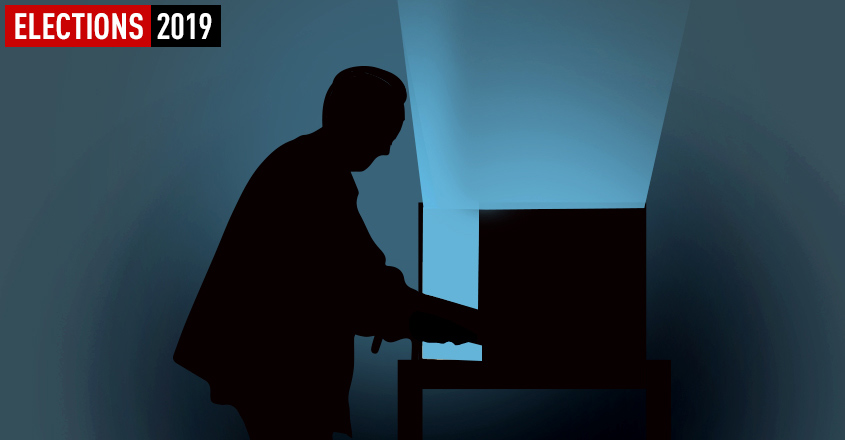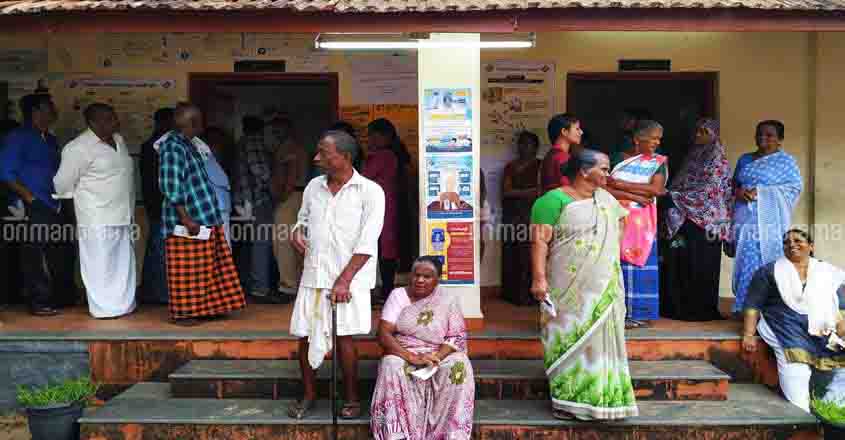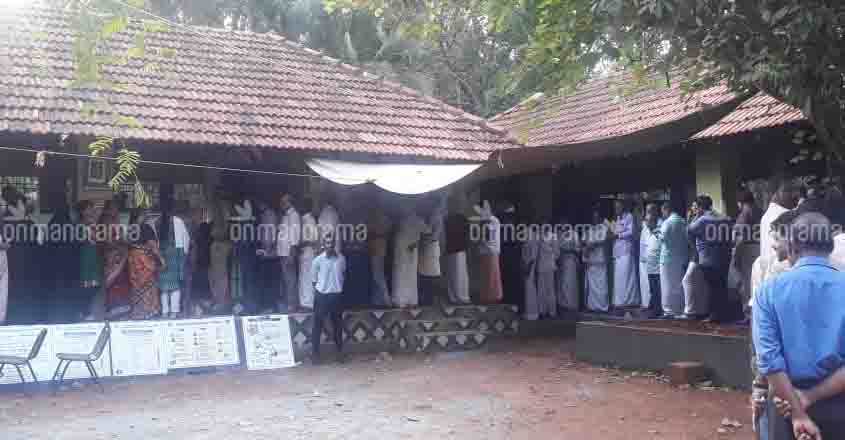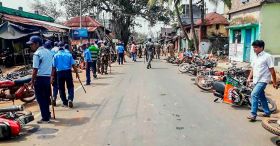
Stats are out and word play is in. So we have varying versions, claims and counter claims about how the surge in voting percentage across constituencies in Kerala will reflect in the number of seats.
Opinion polls have more or less given a slant to the opposition Congress-led United Democratic Front, but then there are differing views on whether the Bharatiya Janata Party (BJP) would make gains.
Unlike in 2014, when the then ruling UDF was facing double incumbency -– the Congress-led front was ruling the centre and state – coupled with the emergence of Modi, there are not many political factors that is backing a strong show by the saffron party.
But then there is Sabarimala, which the BJP counts as a pivot as it hopes to make some inroads in Lok Sabha polls in the state finally.
The moot point on which the BJP's claim rests is that a vast majority of the Hindu community, especially women, is irked by the state government's handling of Sabarimala verdict, which opened the hill shrine for women of all ages.
The BJP sees a conspiracy by the CPM-led government to demolish age-old customs and traditions in the garb of implementing the SC verdict.
The party sees such a rage working out in the majority community too.
Tapping into this perceived anger of the Hindu majority and with the BJP's significant presence in some constituencies, it hopes to win three seats – Thiruvananthapuram, Thrissur and Pathanamthitta.
Going by a rough calculation based on the 2011 census, both Pathanamthitta and Thrissur would have 35% of minorities, who are historically averse to the BJP.
And going by Kerala's political scenario, the Hindu majority has never voted en masse for the BJP-- if that were the case the BJP would have been a significant force long back.

The Hindu community is often split between the LDF and the UDF, but it is a fact that the BJP has made a wedge here of late.
So only if the BJP is going to be a direct, en masse beneficiary of the perceived rage of Hindus triggered by the Sabarimala verdict would the saffron party stand a chance to win.
Now, scenario two is the UDF, which has chosen a middle path in the Sabarimala issue, would gain considerably from the controversy stoked by the apex court verdict on women's entry to the hill shrine.
This seems to be a consensus bet and in case that works out the UDF's prospects are rosy.
Traditionally, the UDF enjoys an edge in Lok Sabha polls, though there are times when it got routed also.
The UDF also hopes to tap into its minority vote base and get back to its fold the Muslim voters who had deserted it to back the LDF in the 2016 assembly polls. That was mainly because the community perceived the Congress as a weakling in the aftermath of the drubbing the party received in the 2014 polls.
The LDF was perceived as the only bulwark which could thwart the strident passions stoked by the Sangh Parivar outfits, especially in the aftermath of the 'beef politics' that played out then. That worked to the LDF's advantage in the 2016 assembly polls.
The LDF, which had always taken a strong stance against the right wing groups, did not hesitate to embrace the apex court ruling on Sabarimala too.
It invoked renaissance values to the hilt with the hope of triggering an outpouring of support from progressive quarters.
It did organise a women's wall as a government-backed programme also, but that was perhaps construed as an affront on the rights of the majority community, regardless of the merits of the argument.
Slowly, the LDF realised that its invocation of renaissance values to aggressively implement the apex court verdict in Sabarimala could have backfired.
So if Sabarimala is indeed an issue, as is being made out to be, the LDF is more or less on a sticky wicket.
Even detractors believe, the LDF government should have highlighted its governance record, which drew flak only in Sabarimala and managing of flood situation, in the run up to the polls.
Though it backtracked from the vehement stand on implementing the apex court verdict, it perhaps earned unnecessary wrath in the process.
That was an issue in which the Pinarayi government should have shown more tact.
A state government's track record may not necessarily be a trump card in Lok Sabha elections, but that was LDF's best bet, given the circumstances.
Going by the election pattern, women outnumbered men as voters.

And the minority community voters apparently came out in full force to cast the ballot.
Minorities are unlikely to pitch for the continuation of a saffron dispensation. Rahul Gandhi's candidature in Wayanad could perhaps rally some minority votes to the UDF camp also.
The resurgence of Congress after it wrested power in three BJP-ruled states last year has also provided the minorities an opportunity to believe that dislodging the BJP government at the Centre is not a distant probability.
For that, they need to back the Congress, and not the Left, nationally - they may still opt for the LDF in the event of an assembly poll.
That leaves women at the focal point of the political spectrum in this Lok Sabha polls.
The LDF has committed women voters. The UDF always banks on the not-so-political women voters.
And the NDA is hoping for a surge in support of women enraged by the Sabarimala row to clinch a seat or two.
Now all these scenarios, permutations and combinations are potential minefields as politics, local factors and candidates can prop up strange results.
For instance, the perception that lower voting percentage would result in gains for a particular front had been busted – and vice versa - in the past and so were opinion polls.
Minority votes have swung either way – to UDF and LDF – and constituencies considered party strongholds have been busted mercilessly in voter rage.
When the BJP made gains in 2016 assembly polls, the LDF was the beneficiary due to circumstances listed above. That may not be the case now.
So the key factors that would decide the outcome of LS polls in Kerala would be perceptions and how political parties have managed that to their advantage.
How Sabarimala issue would play out in this scenario could be a vital factor. This would throw up another host of questions, including how swayed are voters of the majority community – not women voters alone - on the issue and who would stand to gain from it.

The swinging allegiance of the minorities to the ruling and opposition fronts will be another detrimental factor.
The gains, or lack of it, for the BJP will be the final trigger that would be decisive in the ultimate seat count.
Crack these and you are somewhere near the May 23 results.
The only issue is you need to sift through the preferences of 2,03,12,541 voters to reach that moment of truth.
That improbability towers over the sample size of all surveys put together.
In other words, deciphering the outcome of such a gigantic poll exercise should be best left to the official machinery of the Election Commission to count.
Candid Talk: The CPM suspects the BJP voted for the UDF in eight Lok Sabha seats.







